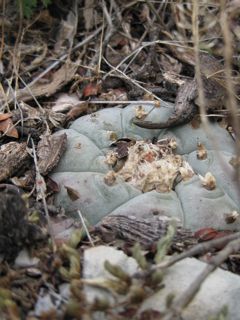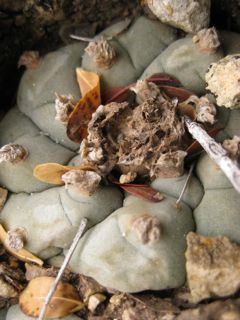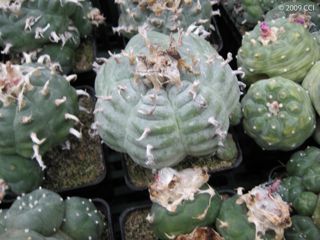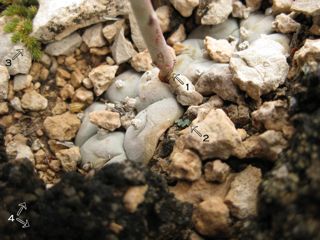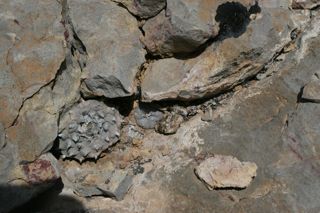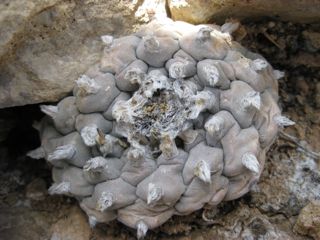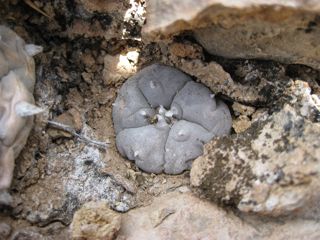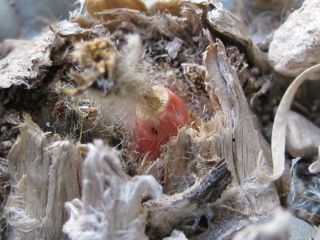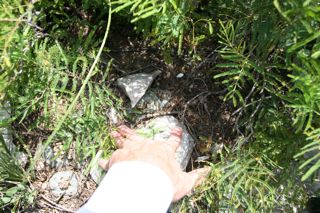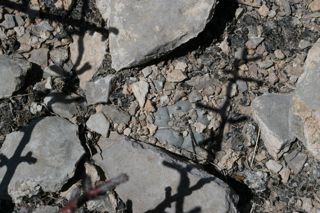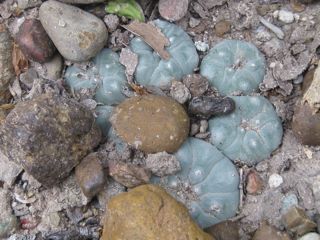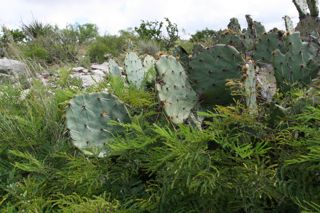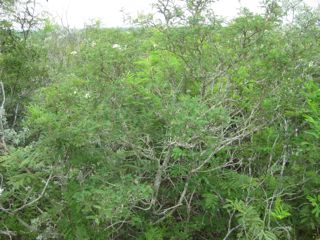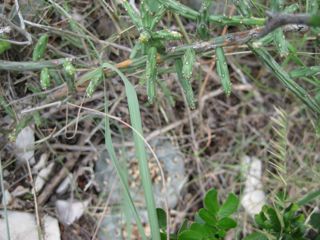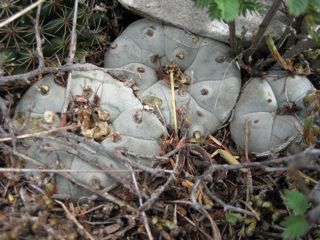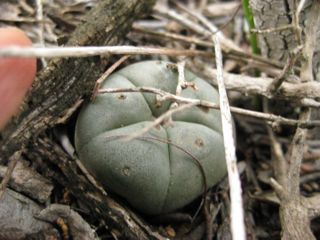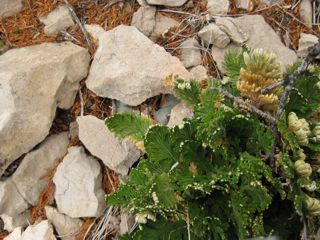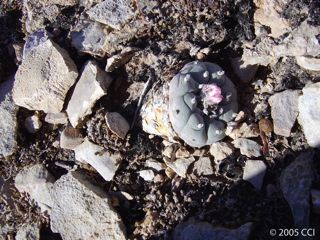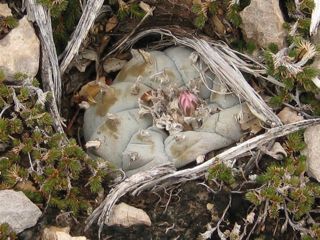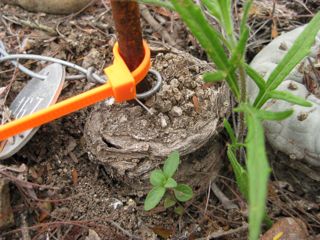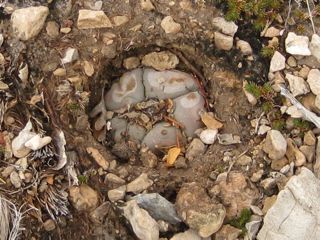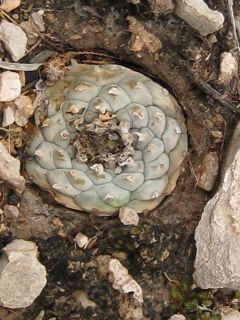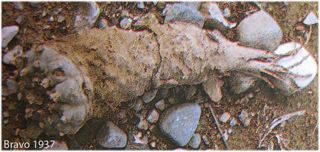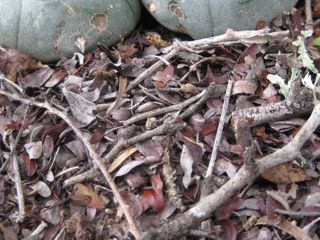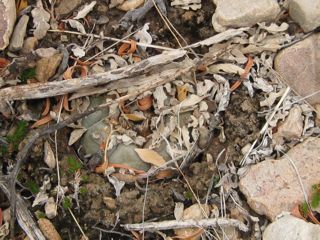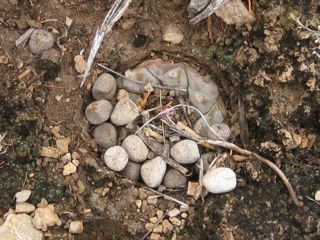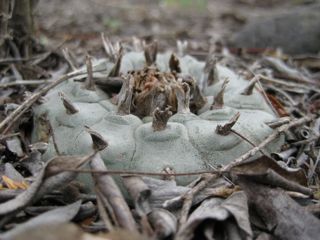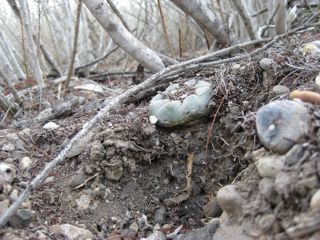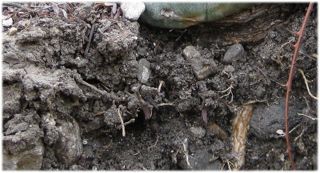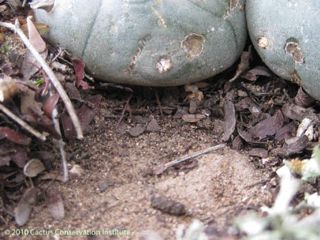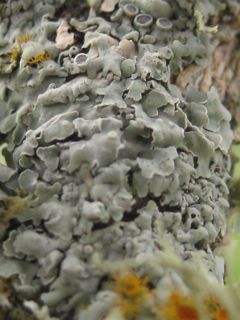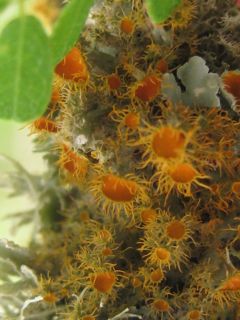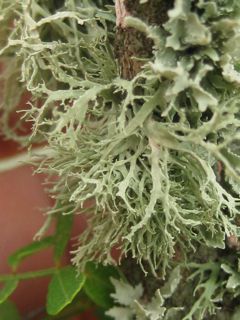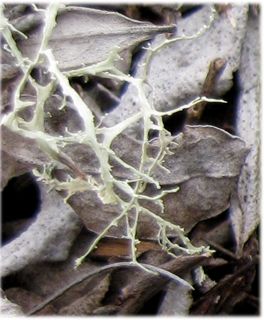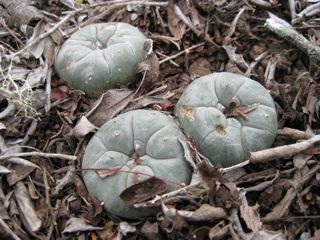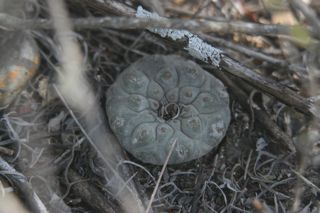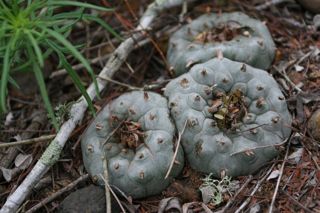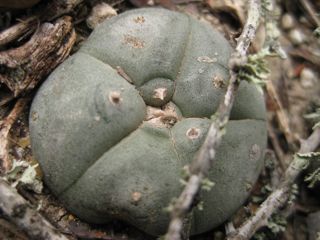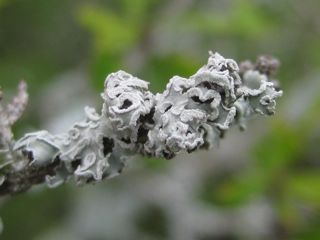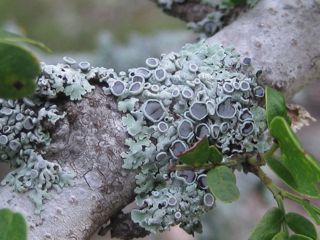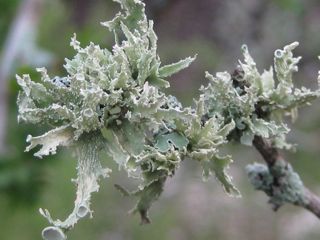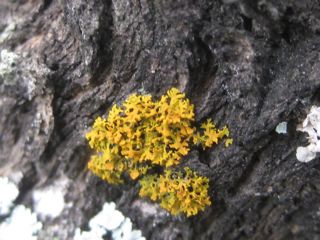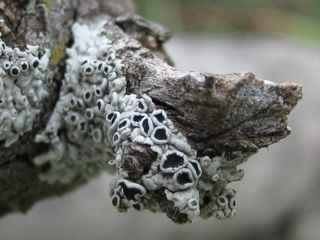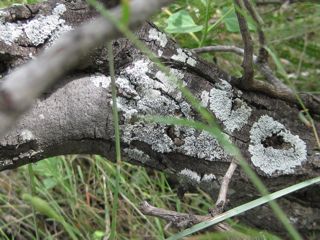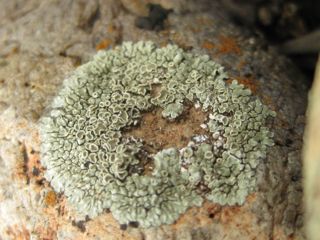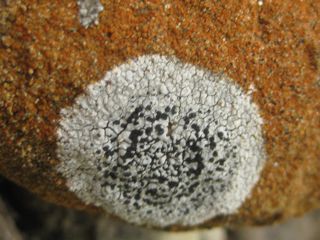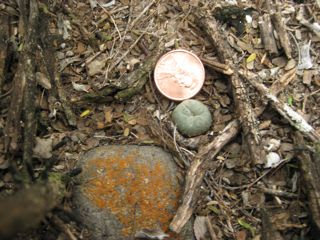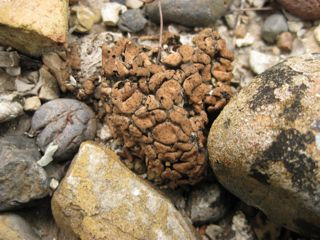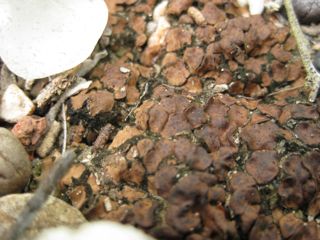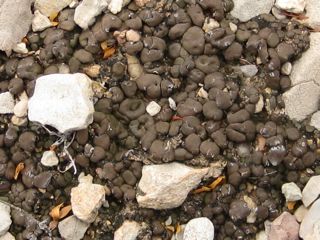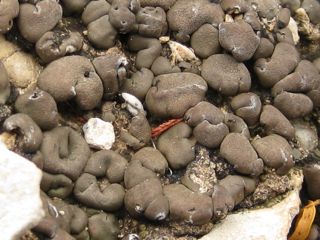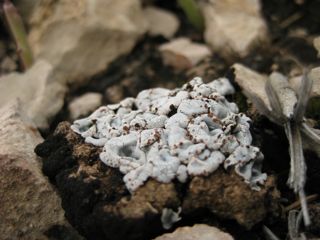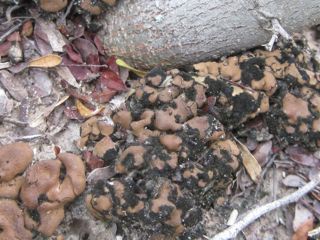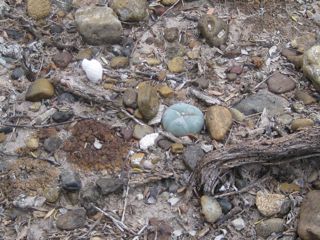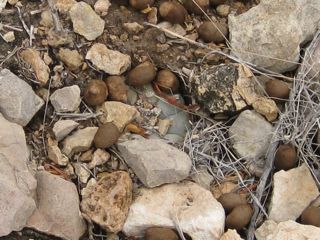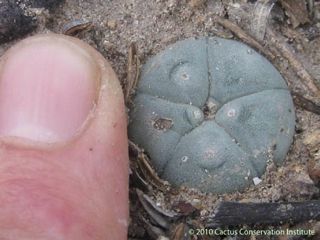Peyote in the Wilds of Texas
v1.0 - Nov 4, 2010
Citation: Trout K, Norton B. "Peyote in the Wilds of Texas". Erowid.org/peyote/peyote_article4.shtml. Nov 4, 2010.
Getting Started
Any cactus wanting to get started faces some challenges, and peyote is no different. However, peyote has a number of advantages over many of the other small globular cacti. It is relatively fast-growing ("relatively" being an important word), designed to live mostly underground with the exposed section adapted to live right at the soil level and be repeatedly buried. It is also incredibly water tolerant and moderately cold hardy. Under the growing conditions of its natural habitat, it regularly survives: 1) abundant rains that can happen any time of year, 2) prolonged drought, and 3) freezing during wet conditions.
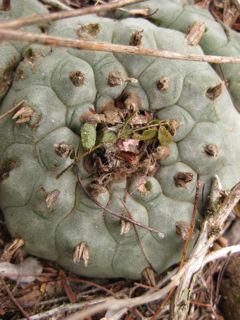
|
Peyote grow easily if their needs are met and their dislikes are understood. It is also possible to cultivate peyote using grafting, in order to force the rate of growth; however, the resulting plants tend to look bloated.
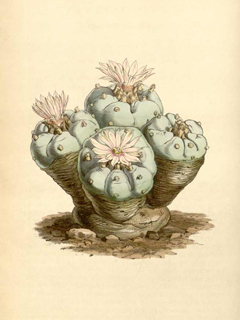
|

|
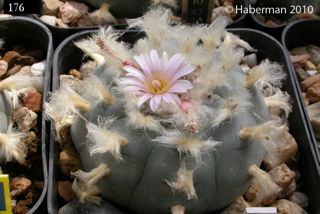
|
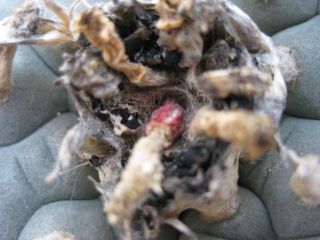
|
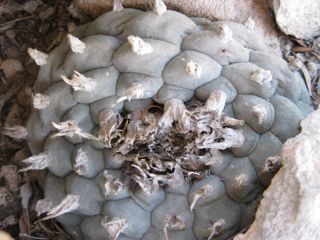
|
Common places presenting the proper niche for peyote seedlings include cracks next to or between rocks located in suitable habitat and alongside the base of the roots of potential nurse plants, where there are not just nooks and crannies to catch the passing seeds, but also decaying plant material and other detritus capable of supplying the required nutrients.
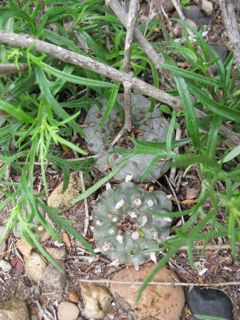
|
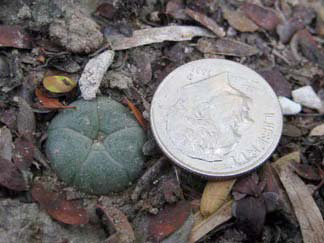
|
These plants, which clearly grew from seeds, have an orientation almost perpendicular to their normal upright habit.
When living in Austin, Texas and propagating peyote many years ago, it was common to observe ants harvesting seeds from peyote fruit as soon as they were ripe. The fruit in the following photograph taken in West Texas shows the same sort of damage witnessed in Austin.
While it is true that peyote receives lots of really hot sun, that sun tends to reach the plants in small patches in between bands of shade provided by the cover plants beneath which peyote grows.
Plants in West Texas often see more direct sun, but careful observation will show that their placement typically has them in spots that receive full sun for only part of the day (unless they have outlived their nurse plant or outgrown their rock). Some plants live in deep shade just fine and often appear to be doing better than those in full sun.
Unlike many plants sprouting underground and sending out new growth that is yellowish, turning green only as it emerges, peyote sends up subterranean branches with heads that can be blue-green and chlorophyllaceous before even emerging above the surface. Its adaptation to tolerate low levels of light is amazing. The head on the left was discovered only during careful excavation of the mother plant and had not yet pushed itself above ground.
The actual timing of development of green on the tips of new underground shoots does not appear to be a subject that has been studied. It is clear that the species' adaptation to living on the edge of being buried is a successful survival strategy.

|
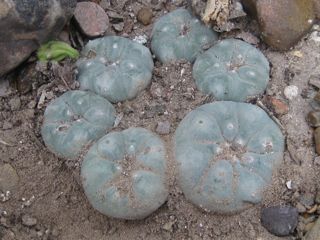
|
Winters in the Chihuahuan Desert extending into West Texas usually see wind and short intervals of freezing cold with minimum temperatures dropping below what is typical for the "Tamaulipan thornscrub" of South Texas. The roots and basal litter of potential vascular nurse plants are spots where peyote seeds can successfully lodge and grow.

|
It's also not uncommon to find plants that hit an obstacle, such as solid rock, and grow sideways or even over it, sometimes resulting in specimens looking more like ancient horticultural masterpieces than typical wild plants.
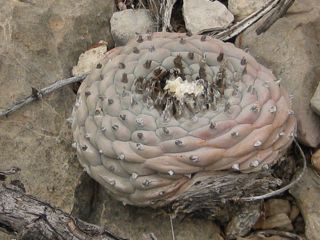
|
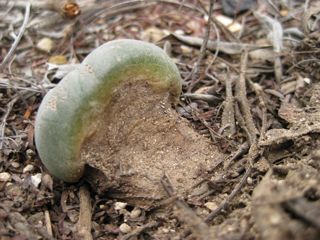
|
Crust Communities
The exact role of members of crust communities with regard to Chihuahuan Desert and Tamaulipan thornscrub peyote remains to be studied in detail. Nevertheless, crusts have proven to be important for other desert life, so there seems no reason to think peyote is not also part of this picture. Crusts are typically formed by various combinations of nonvascular organisms including algae, lichens1, and bryophytes such as mosses and liverworts, or the simple vascular lycophytes like clubmosses. While mosses and liverworts might not be the first plants springing to mind as desert dwellers, it's as common as not to find at least one of the crust community organisms next to or even surrounding peyote, and both mosses and liverworts can exhibit extreme arid climate adaptations.Crust communities are extremely important for securing soil surfaces and they contribute to nutrient availability in two ways: their members eventually become part of the local desert soil through death and decay, and the action of lichens helps to dissolve minerals present in rocks, releasing them in soluble form. Bacteria play a role in this process as well. Peyote's rhizosphere has not yet been studied, but in plants such as Pachycereus pringlei, the zone around the roots has been shown to contain a complement of organisms capable of performing a range of chemical reactions that impact the local surroundings in ways that benefit the cactus. While this subject seems worth studying in Lophophora williamsii var. echinata, it is also clear that the growth habit of peyote itself aids in actively accumulating and creating local compost.
South Texas is similar in some regards to West Texas, as it shares a surprising amount of the same vegetation and both habitats have soils containing abundant available calcium. However, Nature's palette in both areas diverges widely, and these areas are actually quite a bit different in soil and climate.
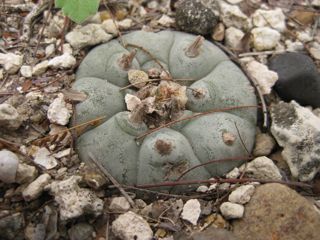
|
This is normal, and an adult plant finding itself buried when it prefers exposure has the capacity of etiolating and pushing its apical meristem well over an inch to reach sun. Its furrowed domelike shape also aids flowing water in uncovering it.
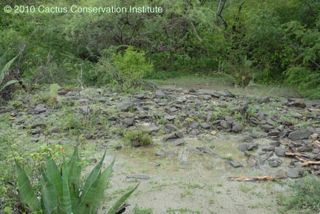
|
Local Soil Creation
Definitions of the parts of the Lophophora plant--"root", "subterranean stem", and "head" (aka "crown")--can be found here. By virtue of its napiform shape, the peyote root constantly burrows downward into the ground. The head, on the other hand, swells with new growth in response to available moisture and contracts during times of drought. Older growth is therefore steadily pulled downward, while new growth emerges from the apical meristem.As is true for many cactus species that grow in temperate climates, peyote typically loses water as winter approaches, making its juice more concentrated. This results in less damage from water crystallizing within its tissues during a freeze. During this drying process, the plant contracts so that the crown is level with, or even below, soil level. As the plant pulls its crown down into itself, this commonly creates a gap that the crown and upper subterranean stem formerly occupied when the plant was turgid.
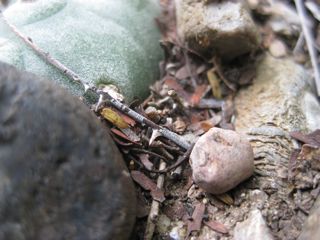
|
When they are present, the peyote's easily removed spikes of stiff hairs can aid in encouraging compostables to catch on and around the plant; the tufts can also encourage the action of the wind in preventing that same plant-generated detritus from completely burying the plants. They appear to be useful features for a spineless cactus living in situations where it is regularly covered with falling debris.
Similarly, while pupping can occur from areoles above ground (especially adjacent to injury), new pups most often form underground from subterranean stem and come up adjacent to the mother plant before expanding with new growth, trapping additional plant debris between themselves and their mother. A clear progression of the states of decomposition--ranging from intact Acacia leaflets to completed compost--can be seen in some of these images.
Due to the abundant surface flow of rain, organics remaining at the surface can easily be washed away down to bare gravel. Thus, these two features--the retention of compost by the plant's habits, and its situation amidst the roots of nurse plants that steadily replenish the supply of organic materials (some of which can be captured long enough to decompose)--appear to be important in creating the soil in direct contact with peyote.
The bases of these nurse plants and grasses can also help catch decomposable materials, as water and wind move lighter materials downhill. Peyote tends to grow on sloping terrain where it is relatively easy for newly dropped raw biomass to be washed or blown away, which prevents the robust creation of local soil. In many areas, what is potentially available to decompose into soil largely gets washed into ravines, leaving a lot of rock and gravel exposed at the surface of open areas.
Soils in arid lands are generally quite poor. This is due to several key factors: 1) high percentage of silicates and mineralization, 2) formation of desert varnish preventing surface incorporation of new materials, 3) low persistence and incorporation of new organics due to factors 1 & 2, and most importantly, 4) arid or desert environments pose serious survival challenges to microbial life.
The observations we've mentioned above concerning peyote suggest that even a soil sample taken some inches away from a peyote plant could be quite different from the less-than-an-inch of soil immediately surrounding the underground stem and root. The importance of understanding local soil creation can't be overestimated. While the deserts soils are largely poor, what is immediately local to a particular plant may not be. This intimately localized enrichment of soil is not limited to peyote, but is a phenomenon that can be widely observed. An interesting example is the hook-thorn African Acacia caffra, termed "wag-'n-bietjie" (meaning those running into one will need to "wait-a-bit"), which purportedly secures animals as large as the occasional ruminant fast in its thorns, where they die and rot, enriching the otherwise impoverished rocky soil in which the Acacia caffra lives (Watt & Breyer-Brandwijk 1962). On a smaller scale, a similar action is performed by fishhook-spined Mammillaria species such as M. grahamii, which snatches lizards and bats.
Some sources of bioavailable nutrients might not be immediately apparent. Several of those have already been illustrated and/or mentioned, namely the assorted bryophytes and lycopods commonly associated with peyote. "Bryophytes" are essentially the nonvascular seedless plants, such as the mosses (Bryopsida), liverworts (Hepatopsida), and hornworts (Anthoceratopsida). "Lycopods" include vascular seedless plants such as clubmosses, spike mosses, and quillworts (Lycopodiopsida). These and the other crust community organisms are commonly referred to by the obsolete generic term "cryptograms". The word cryptogram is now considered a catch-all phrase in taxonomy, as its "members" have been split apart into several kingdoms. It is still in widespread use, due to its convenience in defining various different but frequently co-occurring life forms that may be poorly understood by the speaker making reference to them. Many of the bryophytes and lycophytes may not be particularly prevalent or even present in instances when adequate compost material can be captured and accumulated. Whether bryophytes and lycopods were present or not, assorted lichens were found to be a potential contributor--their dead bodies serve as an organic soil compost component and their mode of growth serves to release available soluble mineral ions during their natural rock-decomposition process. Crustose lichens were commonly encountered adjacent to peyote, colonizing rocks or occasionally soil, while erect and leafy lichens lived on stems and branches of members of the nurse shrubbery above them, falling to the earth along with dead organic material from the nurse plants.
The determination of the yearly biomass produced by Tamaulipan thornscrub, and what relative portions were generated as deciduous leaves, annual plants, barks, wood, lichens, animal droppings, etc., would make for an interesting study.
Digging Even Deeper
Areas of verdant life in desert country are frequently patchy and interrupted with mixed types of plant and fungal life growing together in densely profuse colonies (often even growing in and on each other). There are many reasons for this, including the sometimes-localized ability of plants to get through or around solidly rocky areas, or the presence of an underground water source, or a small zone being of a different geological nature than the surrounding country, or possessing the ability to aid accumulation of organic materials (a ravine, for example). There are other advantages for plants clustering together. They do not simply offer each other potential shade, protection from water erosion, and shelter from wind; in the long run they also may co-create compost and collectively increase moisture retention, resulting in a dynamic growing environment. Carrillo-Garcia (et al. 2000) and Ruiz (et al. 2008), respectively, referred to these as "resource islands" and "islands of fertility", and the Ruiz group makes a noteworthy statement in their opening, that the "abundance of microorganisms in desert soil environments is closely related to the accumulation of resources around individual plants...". Work by these and associated researchers (e.g., Bashan et al. 2005, Puente et al. 2004 & 2007) is illuminating the important role of microbes in making minerals and nutrients bioavailable in harsh environments. In exchange, the plants can exude a variety of materials into the soil, including moisture--further encouraging a healthy zone of bacteria nearby. The ambient moisture provided by the plants also aids long-term bacterial survival during prolonged periods of drought. Cacti are widely believed not to be mycorrhizal2 and instead utilize "plant-growth-promoting bacteria", although exceptions are known.3In Opuntia and Pachycereus living in rocky situations devoid of organics, assorted bacteria and fungi were found to be components living within the cactus rhizosphere, defined as "the region of soil that is immediately near to the root surface and that is affected by root exudates" (Kennedy 1998, in Vega 2007). Citing Prescott, Harley, and Klein (1999), Vega also commented that, "There are different types of substances that diffuse from the roots and that stimulate the microbial activity, such as carbohydrates (sugars and oligo-saccharides), organic acids, vitamins, nucleotides, flavonoids, enzymes, hormones, and volatile compounds....The result is a dense and active microbial population that interacts with the roots and within it." Puente (et al. 2004) reported some of these root-colonizing microbes were able to fix nitrogen, or to produce both volatile and nonvolatile organic acids that were capable of dissolving the elements of the rocky substrate. This process of dissolving rocks has the potential to make significant amounts of minerals bioavailable, including calcium, copper, iron, phosphorus, potassium, magnesium, manganese, and zinc. These microbes are known to cause substantial rock and monument weathering.
There are many organisms known to contribute to rock weathering. Cacti and some Bursera species have been studied due to the microbial components of their rhizosphere. A variable populace of organisms can be involved including fungi, lichens, algae, cyanobacteria, and many other types of bacteria, a number of which can participate in the crust communities discussed above.
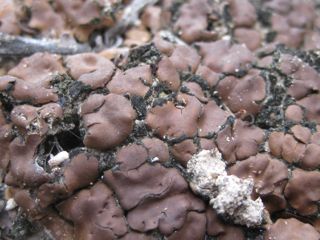
|
Additional Potential Soil Contributions
Herbivore feces--from deer or rabbits and other rodents--are sometimes encountered near or even on top of peyote plants. However, this impacts only some plants--less than 5% of the plants we encountered (although it was occasionally quite common, affecting a much higher percentage on a localized level). Such feces, as well as insect feces, may be a consistent but relatively minor soil contributor when compared to overall deciduous and annual plant-generated biomass, and it would be worth studying the potential impact of local animal feces on growth rates, alkaloid levels, and incidence of natural rot.Conclusions
Lophophora does not appear to be dependent on any one of the following three soil-building factors, but at least one was present in the instances observed to-date:1) Crust community organisms contributing soluble minerals during their lives, and nutrients through their death and decay,
2) The alternating shrinking of old tissues in response to winter and drought followed by new growth, trapping decomposable detritus near the plant body,
3) An ecological situation with an abundant annual yield of vegetative detritus capable of being moved by wind and water.
Microbial flora add a fourth element to this list that is almost certainly an important part of items 1-3. What is visibly occurring with #1 is no doubt also occurring invisibly with bacteria living in the rhizosphere.
Once peyote is past the seedling stage it has relatively few serious challenges that are not the result of humans.
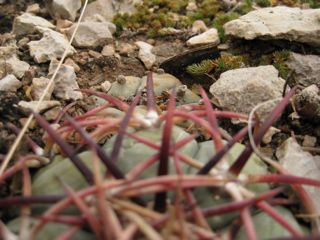
|
References #
- Bashan, Y., et al. 2005. "Prevention of Desert Soil Erosion and Enhancing Soil Stabilization by Mycorrhizal Fungi and by Cactus Plants Inoculated with Azospirillum brasilense". Environmental Microbiology. The Center for Biological Research of the Northwest (CIB), La Paz, B.C.S., 23000, Mexico. (With Á.E. Carrillo, G.J. Bethlenfalvay, A. Rojas, and M.E. Puente.)
- Bravo, Helia. 1937. Las Cactáceas de México Vol. 1. Instituto de Biología de la Universidad Nacional de México.
- Brodo, Irwin M., et al. 2001. Lichens of North America. Yale Univerity Press. (With Sylvia Duran Sharnoff, and Stephen Sharnoff.)
- Cactus Conservation Institute. Any otherwise unreferenced comments pertain to field observations made in 2009 or 2010.
- Carrillo-Garcia, Ángel, et al. 2000. "Effects of Resource-Island Soils, Competition, and Inoculation with Azospirillium on Survival and Growth of Pachycereus pringlei, the Giant Cactus of the Sonoran Desert". Restoration Ecology 8 (1): 65-73. (With Yoav Bashan, Ernesto Diaz Rivera & Gabor J. Bethlenfalvay.)
- Hooker, William Jackson. 1847. "Tab. 4296. ECHINOCACTUS Williamsii. Mr. Williams' Echinocactus". Curtis's Botanical Magazine. 73: 85-87. (Vol. 3 of the third series, or Vol. 73 of the whole work.)
- Kennedy, A.C. 1998. "The Rhizosphere and Spermosphere." Pages 389-407 in: Sylvia, D.M. et al. (eds.) Principles and Applications of Soil Microbiology. Englewood Cliffs, NJ: Prentice-Hall. (Cited by Vega 2007, although he appears to have presented a few details of the citation in error that we have corrected here. With J.J. Fuhrman, P.G. Hartel, and D.A. Zuberer.)
- Prescott, Lansing M. et al. 1999. Microbiology. 4th edition. Boston: Mc Graw-Hill. (Cited by Vega 2007. With John P. Harley and Donald A. Klein)
- Puente, M. Esther, et al. 2004. "Microbial Populations and Activities in the Rhizoplane of Rock-Weathering Desert Plants I. Root Colonization and Weathering of Igneous Rocks". Plant Biology 6: 629-642. (With Y. Bashan, C.Y. Li, and V.K. Lebsky.)
- Puente, M. Esther, et al. 2009. "Rock-Degrading Endophytic Bacteria in Cacti". Environmental and Experimental Botany 66: 389-401. (With Ching Y. Li and Yoav Bashan.)
- Ruiz, T.G., et al. 2008. "Fertility Islands Around Prosopis laevigata and Pachycereus hollianus in the Drylands of Zapotitlán Salinas, México". Journal of Arid Environments 72 (7): 1202-1212. (With S.R. Zaragoza and R.F. Cerrato.)
- Safford, William E. 1916. "Narcotic Plants and Stimulants of the Ancient Americans." Annual Report. Smithsonian Institution. Pages 387-424.
- Vega, Nelson Walter Osorio. 2007. "A Review on Beneficial Effects of Rhizosphere Bacteria on Soil Nutrient Availability and Plant Nutrient Uptake". Revista Facultad Nacional de Agronomía, Medellín 60 (1): 3621-3643.
- Watt, John Mitchell and Maria Gerdina Breyer-Brandwijk. 1962. The Medicinal and Poisonous Plants of Southern and Eastern Africa. Second edition. Edinburgh: E. & S. Livingston, Ltd.
- Image Credits: Photos are by Keeper Trout, Burnt Norton, and Cactus Conservation Institute unless otherwise noted. For uses outside this document, please contact one of the authors or copyrights@erowid.org.
- Lichens are often regarded as mutual symbionts, but a closer look will show that while the fungal portion of a lichen may be constant throughout its range, its choice of algae or other photobionts can vary dramatically (a photobiont is the organism that a lichen selects to perform photosynthesis on its behalf). In most cases the relationship of the fungus to the photobiont it provides with shelter and a growing space lies somewhere in between that of a parasite and a factory farm. The alga or bacterium is permitted to live, but it is interpenetrated by hyphae feeding from it, while it is maintained solely for the continued sustenance of the fungus (Brodo et al. 2001).
- See note on Caryophyllales at http://www.mobot.org/MOBOT/research/APweb/orders/caryophyllalesweb.htm#Caryophyllales.
- For example, see the thesis "Mycorrhizal associations in Opuntia humifusa in southern Illinois", and references within it (Whitcomb 2000), posted at http://opensiuc.lib.siu.edu/cgi/viewcontent.cgi?article=1089&context=uhp_theses.


